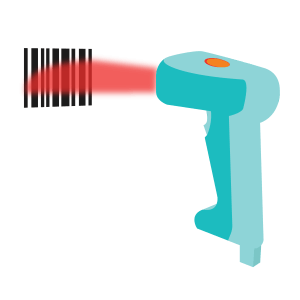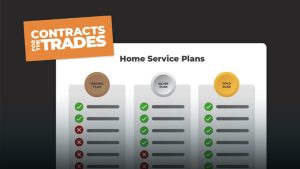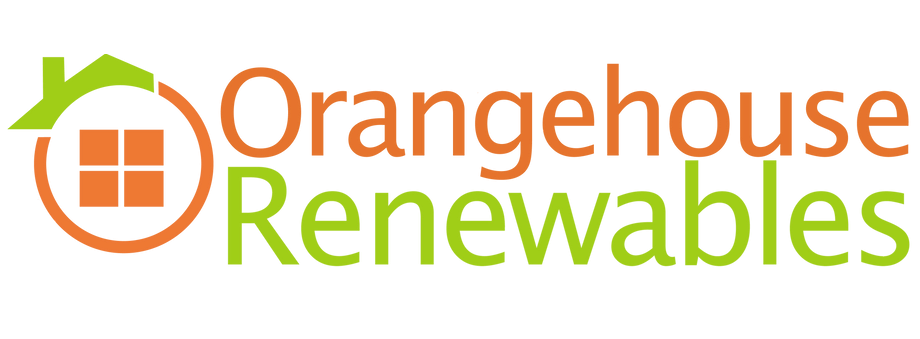7 Essential Features of a Stock Control System for the Trades
January 31, 2024 | Read: 10 minutes

If you’re planning on using a stock control system, you’ll discover the features that you must have, below.
Whether you’re unnecessarily stockpiling, being slowed down by tedious admin, or are fed up with stock disappearing, it may reassure you to know there’s a better way to manage your stock…
Of course, if you’re new to the software management marketplace, or are looking to upgrade your stock control solution, you may already have an idea of what you need.
But even with that knowledge, we’ve made clear the features of a stock control system that you really can’t do without!

What is a Stock Control System?
A stock control system is a digital tool that lets you oversee and manage your stock/inventory. Typically, instead of relying on paper or an Excel spreadsheet, you’ll use specialist stock control software on a device—like a mobile phone, tablet, or computer— to manage your stock.
A comprehensive system will let you track your stock, assign parts to specific jobs, see where an item is, and even automatically order spare parts when you’re running low.
You can rely on a stock control system to make life easier and—especially if you have a warehouse with a dedicated stock manager—many of the features of a stock control system that we’ll cover will streamline their operations.
Stock control can also yield financial benefits. After all, when you can see your inventory clearly laid out in front of you, you can prevent over stocking items, and ensure you only purchase what you need.
Of course, you should keep in mind that not all stock control systems are made equal.
This is why we’ve outlined the features you should look out for when buying or upgrading a stock management tool. Let’s check them out:
7 Must-Have Features of a Stock Control System
1. Set appropriate authority levels
When using software, it can be tempting to give everyone access so that they can manage their tasks. However, a structure provides order and setting restrictions on what some staff can and can’t do in the app can help prevent costly mistakes.
This is where setting authority levels is incredibly helpful. It’s about delegating responsibility and giving high levels of control only to those who need it. This can can prevent errors, like accidentally duplicating orders, or ordering too much expensive stock by accident.
While giving everyone unrestricted access can work—especially if you only have a few employees—it can quickly get messy for larger businesses.
Instead, by delegating levels of control, your senior team can more precisely manage stock and junior staff can focus on getting the parts they need to do a job.
But, importantly, you’ll want a system with flexible authority levels.
This means that you can makes adjustments as people learn to use the system or pivot as your business grows.
There are other practical benefits to consider, such as if a manager is off sick, or on holiday. You could grant temporary controls so that work can continue, but then easily revoke access later, if needs be.
Setting different authority levels over stock control can also help you to train staff. You might start a trainee on a lower level i.e. they can only request parts to begin with. But as they learn, you can increase authority and give them more control, so they can place orders with suppliers themselves.
Ultimately, authority levels are great way to ensure that everyone can work together. They’ll also protect your company from expensive surprises.
2. Use a built-in barcode scanner
Stock control is an undeniably physical process. You can order the parts you need online and get them delivered, but the knowing how to organise a stockroom help you be successful

Ideally, you need a way to speed up data entry and that’s precisely where a barcode scanner comes in. It’s an essential feature of a stock control system!
With a barcode scanner—like the image above, or one you can use on a mobile device—it will make managing your stock much easier.
After all, stock may end up in all sorts of different places. It could be a warehouse, a smaller storeroom, or even inside vans. A major benefit of stock control barcode software is that you can use it to build a digital library of stock, no matter where the pieces end up. (Of course, it will also help you make it clear where they do end up, too)!
When parts arrive from the supplier to your stockroom, the stockroom manager can simply scan the delivered parts, logging the details in moments. They can also compile data against stock types you’ve already logged, saving time in the future, too.
Barcode scanning means benefitting from precise, real-time stock-level monitoring and a whole lot less time-consuming effort.
3. Generate insightful analytics
With stock control and parts management software, you stand to get a much better picture of what’s coming in and out of your business, every day.
- Time stamps can tell you when parts have been taken out.
- Job notes can reveal what bookings they were used on.
- You can even work out which engineer handled them.
For instance: let’s say an engineer is regularly taking care of jobs in a particular area. However, it turns out this area isn’t near your warehouse, so they’re travelling far to get the necessary stock before driving all the way to attend the job.
That’s not efficient.
As a result, time and money are being wasted.
However, by digging through the data, you can make informed logistical decisions. You might see that it’s worth investing in a bigger van so they can carry more parts. Or perhaps it’s worth opening up a new storage site, as it’ll help more of your team in that area, too. As a result, your business can grow to provide for more customers, and staff can work more efficiently!
In this way, a stock control system can help you uncover untapped potential.
With useful data, you’ll be able to drum up a clear picture of which parts you use most often. You can then put in bulk orders for parts you know you need, (rather than best guesses). Such data improves accuracy and makes it far less likely you’ll overstock (or understock) essential equipment. This makes it one of the best features of a stock control system.
4. Integrates with job management software
While spreadsheets improve upon paper-based systems, many businesses will find spreadsheets are no longer the most efficient tools to manage stock.
While spreadsheets are useful, they can be unwieldy, especially if you’re trying to use other data systems to track and connect information.
What you need is an all-in-one software tool that includes stock control.
Having a dedicated stock control system that’s built into your job management software of choice, like Commusoft, makes a whole lot of sense.
By integrating jobs, financial, and stock data together, your business can become much more efficient. It’s all about finding the best way to connect with your team and give them the data they need.
Even better, when data can connect in real-time, everyone can see the information they need, when they need it. They can check job details, find invoices, create purchase orders, and more.
It’s a case of working smarter, not harder.
Parts and Stock have helped CP Jefferies achieve success, too! Hear more below:
– – –
5. Automatic supplier integration
If you’re regularly running low on parts, automating supplier orders can be a particularly useful feature of a stock control system.
Understandably, you’ll be dealing with your suppliers a lot: ordering parts, completing purchase orders, and paying invoices. The benefit of supplier integrations is that they can drastically improve how your business interacts with your suppliers.
For instance, an automated tool can help your team to easily raise purchase orders to suppliers, even without needing anyone to get involved. Further, generating a PO and understanding how to track purchase orders with software will save heaps of admin time, too.
Staff can simply check the generated PO, rather than have to build it all themselves.
If a stock control system can automatically order essential parts to ensure you’re never running low, it’s well worth having. It means you can ensure:
- You never lack the parts you need for any job.
- Admin gets done quickly, accounting for all the items you need.
- Purchase order history makes it easy to see what you’ve bought and when.
With a workflow engine supporting your efforts, you can ensure engineers can always access the parts they need. And by improving communication with your suppliers, you can build on your working relationship with them. Not only that, it’ll be even easier to stay on top of finances.
If low stock levels were causing issues, you’ll also likely see improvements to first-time fix rates, customer satisfaction, and even find you help you’re more profitable, too. What’s not to like?
6. Cloud-based storage solutions
Gaining access to stock data on the go means your engineers can work wherever they are.
With cloud software, you don’t need to wait.
Whether on the road, in their home, or at the office: they can always track down the parts they need.
More than ever, your team should have the power to work efficiently, wherever they are.
A cloud-based software tool ensures that’s the case, which is especially great for time-sensitive work and emergency appointments.
Need we say more?
7. Stockroom and van location tracking
Vans have a tendency to become mini-storage units. This might’ve been an issue before you started using stock control software, but combined with real-time vehicle tracking, it’s not unreasonable to use these tools to make the most of your vans.
Much like being able to access your database everywhere you go, having the option to track vans also means you can track the items that are stored inside them; especially if they’re recorded accurately on your database.
This can go a long way towards helping you stay organised and keep track of every detail.
Vehicle tracking in general is an excellent way to improve the way you manage your team, but add tracking inventory to that list, and it’s a recipe for success.
Your engineers can rest easier and work faster when they know that tools and spare parts they need are only steps away, not miles.
Explore Commusoft’s Stock Control System
When you use field service management software, you gain access to these seven essential features of a stock control system, you now know what to be on the lookout for.
It’s important to take these points into consideration and sure-up stock management in your field service business.
If you’d like to improve how you manage stock for your field service business, take a look at Commusoft. Our Stock Control software can help:












